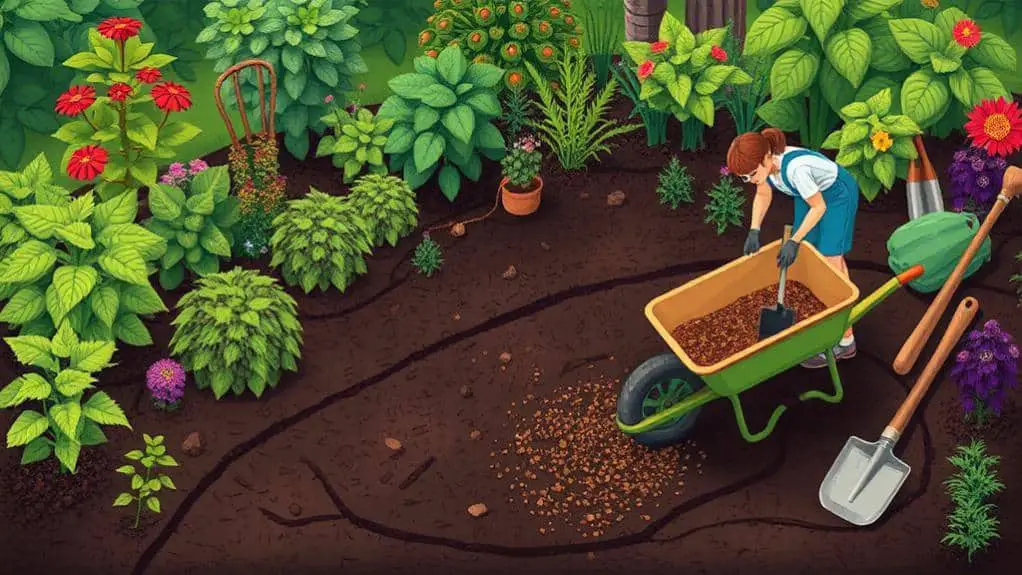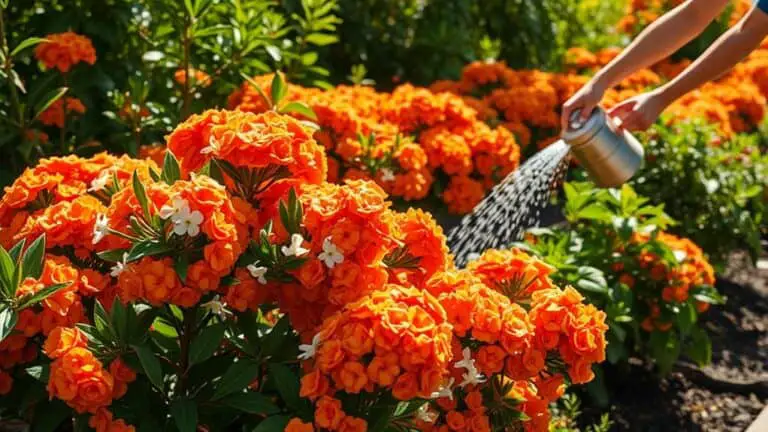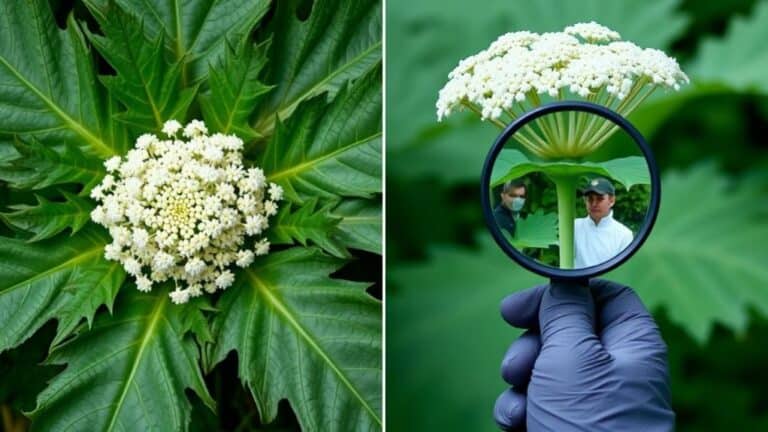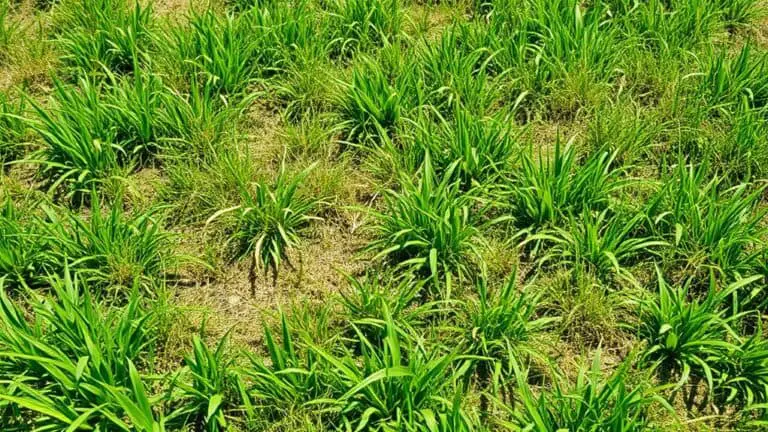Improve The Heavy Clay Soil In Your Garden
Think of your garden’s heavy clay soil as a locked treasure chest; the key to revealing its potential lies in improving its structure and fertility. I’ve found that adding organic matter, like compost or well-rotted manure, can make a significant difference. But that’s just the beginning. Have you ever wondered how aeration techniques or gypsum might help? Or what specific plants thrive in such conditions? There’s a lot more to explore when it comes to transforming your clay soil into a thriving garden environment.
Benefits of Clay Soil
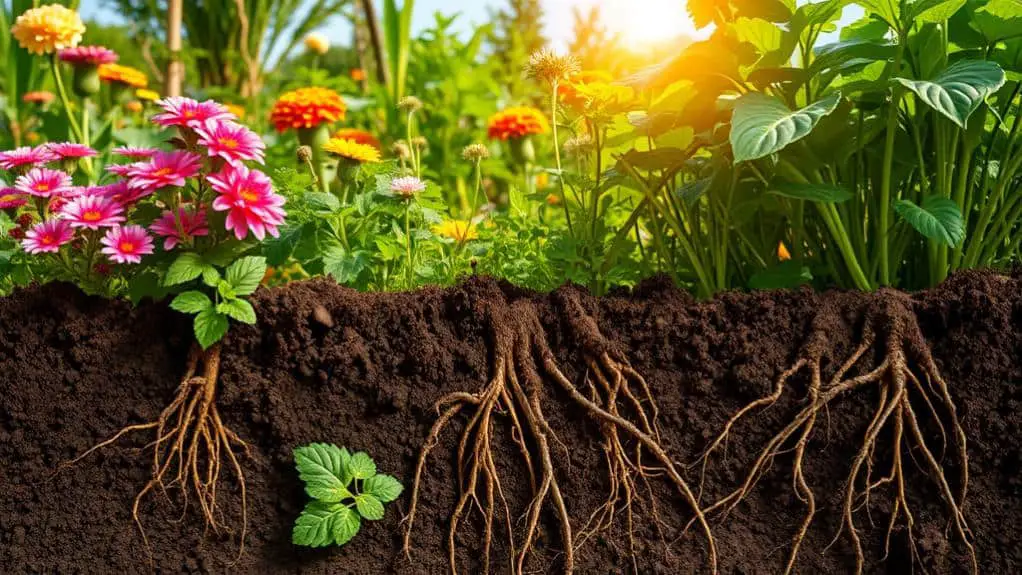
Clay soil mightn’t have the best reputation among gardeners, but it actually comes with several significant benefits.
For starters, it’s incredibly beneficial for plants needing consistent hydration. Its high moisture retention means you don’t have to water as often.
Plus, clay soil holds onto essential nutrients effectively, which boosts soil fertility and supports diverse plant growth. The slow release of these nutrients guarantees that your plants get a steady supply over time, fostering sustained health.
Additionally, clay soil provides a stable root environment for plants that thrive in heavier soils.
It also supports diverse ecosystems, creating a healthy garden environment filled with beneficial microorganisms and insects.
Challenges of Compacted Clay
Despite its benefits, working with compacted clay soil can be quite challenging. The tightly packed clay particles severely restrict the movement of air, water, and nutrients, creating poor conditions for plant growth.
Just walking on wet clay or heavy rainfall can worsen compaction, making it even harder for roots to develop and increasing the risk of root diseases. The flat shape of clay particles means they pack together more easily than the rounded particles in other soils.
This often results in nutrient deficiencies for plants since the limited movement makes nutrients less accessible to roots. Additionally, salts from fertilizers can accumulate in compacted clay soil, further complicating plant health.
It’s important to understand these challenges to effectively manage your garden soil.
Conducting Soil Tests
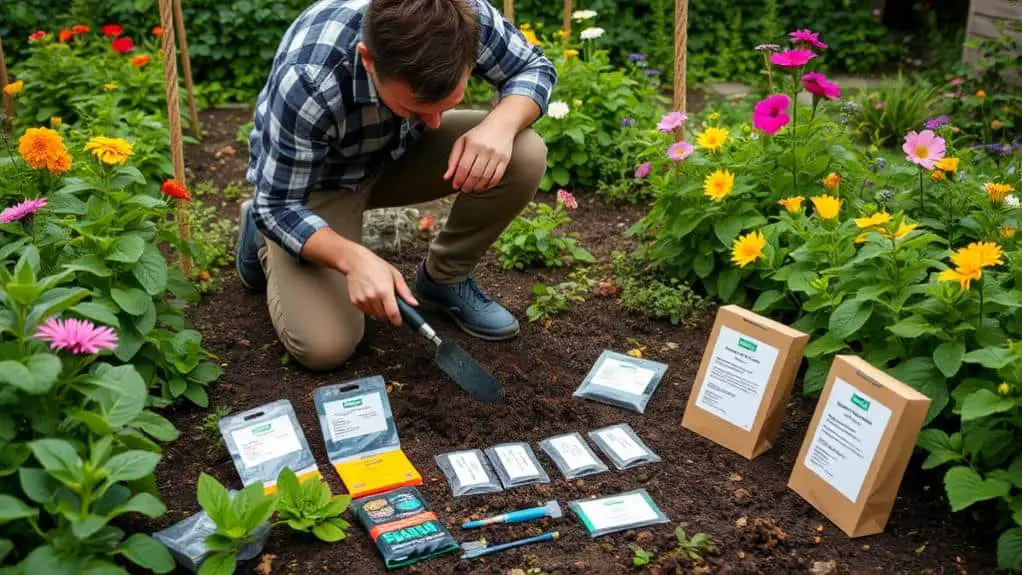
One of the most effective ways to tackle the challenges of heavy clay soil is by conducting regular soil tests.
Testing every 3-4 years helps me assess organic matter, pH, and nutrient levels, making my gardening decisions more informed. A thorough soil test analyzes nutrient availability, soil texture, and pH, which are vital to understanding how to amend clay soil.
I can use local agricultural extension services or commercial labs to get detailed reports on soil health. Identifying specific nutrient deficiencies allows me to add targeted amendments, like lime for pH adjustment or gypsum to improve soil structure.
Regular testing guarantees my soil amendments remain effective, promoting healthier and more productive plant growth over time.
Adding Organic Matter
Let’s talk about the magic of adding organic matter to heavy clay soil!
By mixing in compost, well-rotted manure, or even leaf mold, we can transform our dense soil into a more friable, plant-friendly environment.
I’ll share tips on the best types of organic materials to use and how to apply them effectively, so your garden can thrive.
Types of Organic Matter
Adding organic matter is one of the best ways to transform heavy clay soil into a more workable and fertile medium. By incorporating various types of organic material, you can greatly enhance your garden’s soil structure.
Here are four types of organic matter you can use:
- Compost: Rich in nutrients, compost improves soil fertility and microbial activity.
- Leaf mold: Made from decomposed leaves, it helps increase soil aeration and moisture retention.
- Well-rotted manure: Adds essential nutrients and beneficial bacteria to the soil.
- Grass clippings and veggie scraps: These are readily available and cost-effective, enriching the soil with organic matter.
Each option helps break down heavy clay, making your garden more productive and easier to manage.
Application Best Practices
Now that we comprehend the different types of organic matter, let’s talk about how to apply them effectively to heavy clay soil. For ideal results, incorporate 3-6 inches of organic matter, like compost or well-rotted manure, into the top 6-12 inches of soil before planting. Apply these soil amendments in 2-3 inch layers to improve rain penetration and prevent compaction. To maintain soil health, add 1-3 inches of organic mulch annually. Avoid mixing sand or peat moss, as they can worsen drainage. Regular soil tests every 3-4 years guarantee tailored improvements.
| Amendment | Layer Thickness | Benefits |
|---|---|---|
| Compost | 2-3 inches | Enhances structure |
| Manure | 2-3 inches | Adds nutrients |
| Mulch | 1-3 inches | Retains moisture |
Using Gypsum
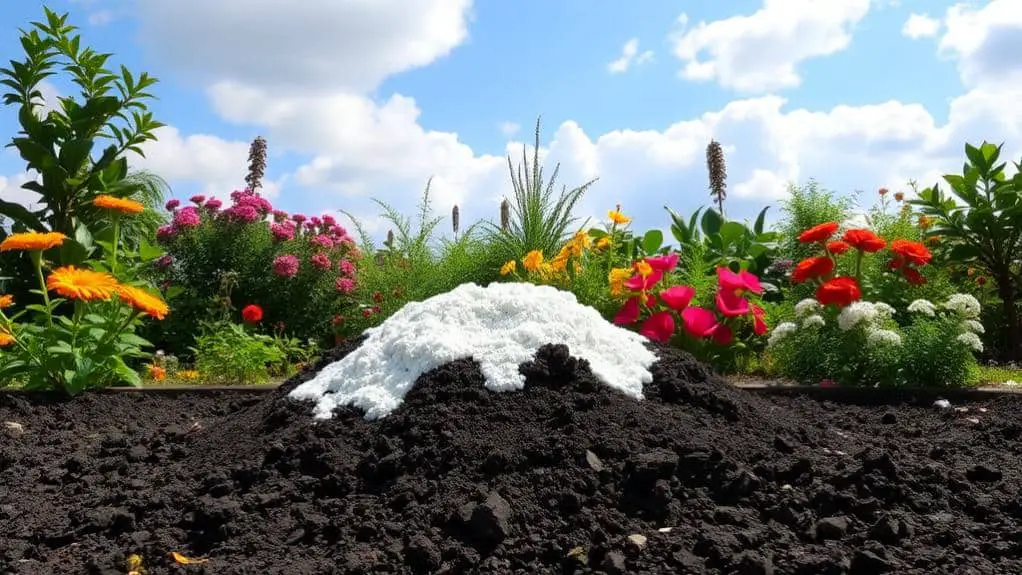
Applying gypsum to heavy clay soils can be a game-changer for gardeners and farmers looking to improve their soil structure and drainage.
Gypsum, or calcium sulfate, doesn’t alter soil pH but provides essential nutrients like calcium and sulfur, which are crucial for plant health.
Here’s why you should consider using gypsum:
- Improves Soil Structure: Gypsum helps break up heavy clay soil, making it easier for roots to grow.
- Enhances Water Penetration: It allows water to seep into the soil better, reducing waterlogging.
- Provides Nutrients: Gypsum adds calcium and sulfur, necessary for preventing issues like blossom end rot in tomatoes and peppers.
- Reduces Compaction: It makes the soil less compact, giving roots more access to nutrients and moisture.
Give gypsum a try for noticeable soil improvement!
Regular Aeration
Regular aeration is super important for improving heavy clay soil because it helps reduce compaction and lets air, water, and nutrients reach plant roots more easily.
You can use methods like core aeration, which removes small plugs of soil to boost porosity and drainage.
To get the best results, aerate your clay soil at least once a year, preferably during the growing season when plants need it most.
Benefits of Aeration
Many gardeners struggle with heavy clay soil, but regular aeration offers a practical solution to this problem.
By aerating, I can improve the soil’s structure and enhance its overall health. Here are four benefits of regular aeration:
- Relieves Compaction: Aeration breaks up dense soil layers, allowing for better air, water, and nutrient movement.
- Enhances Drainage: Improved soil structure reduces waterlogging, which is common in clay soils.
- Promotes Healthy Microbial Ecosystem: Creating small holes encourages the infiltration of water and organic matter, fostering beneficial microbes.
- Increases Oxygen Availability: Annual aeration boosts oxygen in the root zone, essential for root and microorganism respiration.
Combining aeration with organic amendments like compost can further enhance these benefits.
Aeration Techniques
Aeration techniques can make a world of difference for heavy clay soil. By creating small holes, about 2-4 inches apart, you allow air, water, and nutrients to reach deeper into the soil.
Using a core aerator is especially effective, as it removes plugs of soil, reducing compaction and improving soil structure over time. After aerating, adding organic amendments like compost or gypsum can further enhance these benefits.
Regular aeration not only helps in improving soil by alleviating compaction but also promotes root growth and fosters a healthier soil ecosystem. The improved drainage and increased microbial activity make your garden thrive.
Timing and Frequency
While aeration techniques can breathe new life into heavy clay soil, knowing when and how often to aerate is equally important.
I’ve found that timing and frequency are essential for ideal results. Here’s a quick guide:
- Annual Aeration: Perform aeration annually to relieve soil compaction and enhance air and water movement.
- Seasonal Timing: Aim for spring or early fall when the soil is moist but not overly saturated.
- Core Aerator: Use a core aerator to remove small plugs of soil, improving nutrient access and root health.
- Organic Matter: Follow up with organic matter like compost or mulch to fill holes and boost soil structure.
Consistent aeration can transform heavy clay soil, making it more workable and plant-friendly.
Choosing Suitable Plants

When selecting plants for heavy clay soil, it’s crucial to choose varieties that are naturally adapted to these conditions for ideal growth and resilience.
Native species, like black-eyed Susans and coneflowers, thrive in heavy soils and can help improve clay soil. Their deep root systems break up compacted layers and enhance soil structure.
Drought-resistant varieties such as daylilies and ornamental grasses also tolerate the moisture retention of clay soil.
Perennials like sedum and asters are great choices, requiring less maintenance while thriving in nutrient-rich environments.
To further support these plants, regularly apply compost and organic matter. This not only improves plant health but also enhances the soil quality over time, making your garden flourish.
Mulching Techniques
Mulching is an essential technique for managing heavy clay soil. By applying a layer of organic mulch, you can improve your garden’s soil health. Here’s how:
- Moisture Retention: A two to three-inch layer of mulch helps retain moisture in the soil, which is vital for plant health.
- Weed Suppression: Mulch suppresses weeds, reducing competition for nutrients and making your gardening tasks easier.
- Soil Temperature Regulation: It keeps the soil cool in summer and warm in winter, providing a stable environment for plant roots.
- Microorganism Activity: Organic matter in mulch encourages beneficial microorganisms and earthworms, which enhance soil structure and fertility.
Remember to replenish the mulch annually, applying it in the fall or early spring for the best results.
Long-Term Soil Management

When it comes to long-term soil management, regularly adding organic matter like compost or well-rotted manure can really transform heavy clay soils.
I recommend testing your soil every season or two to keep an eye on nutrient levels and pH, so you can make any needed adjustments.
Stick with it, and you’ll see your soil become healthier and more fertile over time!
Consistent Organic Matter Addition
Over time, adding organic matter regularly can transform heavy clay soil into a more manageable and fertile medium for gardening.
Improving clay soil isn’t instantaneous, but with dedication, you can enhance soil health and structure. Here’s how:
- Add Compost or Manure: Incorporate 3-6 inches of compost or well-rotted manure annually. This improves soil texture and drainage.
- Deep Incorporation: Mix organic matter deeply, ideally within the top 6-12 inches. This enhances aeration and root growth.
- Use Organic Mulch: Apply 1-3 inches of organic mulch. It retains moisture, suppresses weeds, and boosts soil fertility.
- Be Patient: Understand that transforming clay soil is gradual. Regular additions are key for long-term soil health.
Soil Health Monitoring
Monitoring soil health is essential for long-term soil management, especially when dealing with heavy clay soil. Regular soil testing every 1-2 years is a must. It helps me assess nutrient levels, soil pH, and organic matter content, so I can make the right amendments.
Keeping an eye on calcium levels is also vital, especially for crops like tomatoes and peppers. I’ve found that a consistent soil-building program, rather than just one-off fixes, truly transforms my soil over time.
A thick layer of organic mulch protects the soil, reduces evaporation, and supports beneficial microorganisms. By observing changes in soil structure and crop performance, I can see what’s working and make any needed adjustments.
Cost-Effective Strategies
Improving heavy clay soil doesn’t have to break the bank.
I’ve found some fantastic, cost-effective strategies to enrich our garden beds without spending a fortune.
1. Utilize free local resources: Collect horse manure and grass clippings to boost soil structure and fertility.
They’re rich in organic matter and often free from local farms or neighbors.
2. Community gardening: Join local groups to share compost and mulch.
It’s a great way to access organic inputs affordably.
3. Transport bulk materials: Rent or borrow a pickup truck to haul bulk compost, wood chips, or other amendments.
It saves on transportation costs.
4. Layer wood chips or straw as mulch: This not only helps retain moisture and suppress weeds but also reduces the need for pricey weed control solutions.
These steps can make a big difference without big spending!
Frequently Asked Questions
How to Fix Heavy Clay Garden Soil?
To fix heavy clay garden soil, I incorporate soil amendments like compost and gypsum to improve drainage. Choosing the right plant selection helps too. Regularly aerating the soil guarantees better water and nutrient access for healthy plants.
How to Break up Hard Clay Soil?
Think of your garden soil as a stubborn wall. I break it down with soil aeration techniques, like using a tiller. Then, I add clay soil amendments like compost and cover crops, ensuring better garden drainage solutions.
Do Coffee Grounds Improve Clay Soil?
Yes, coffee grounds improve clay soil. They offer benefits like better structure and drainage. As a soil amendment, they boost nitrogen and microbial activity. My gardening tip: use them in moderation for balanced soil health.
What to Do With Excess Clay Soil?
Isn’t it lovely to have excess clay soil? You can use it for raised beds! Add soil amendments like compost for better drainage solutions and try different planting techniques. Trust me, your plants will thank you.
Conclusion
Imagine your garden as a superhero in disguise, with clay soil being its secret identity. By adding organic matter, using gypsum, and choosing the right plants, you’re giving it the power to thrive. Regular soil tests are like a superhero’s check-up, ensuring everything’s in tip-top shape. Embrace these steps, and watch your garden transform from a struggling sidekick into a flourishing hero. With patience and care, your garden will become a lush, vibrant oasis.

